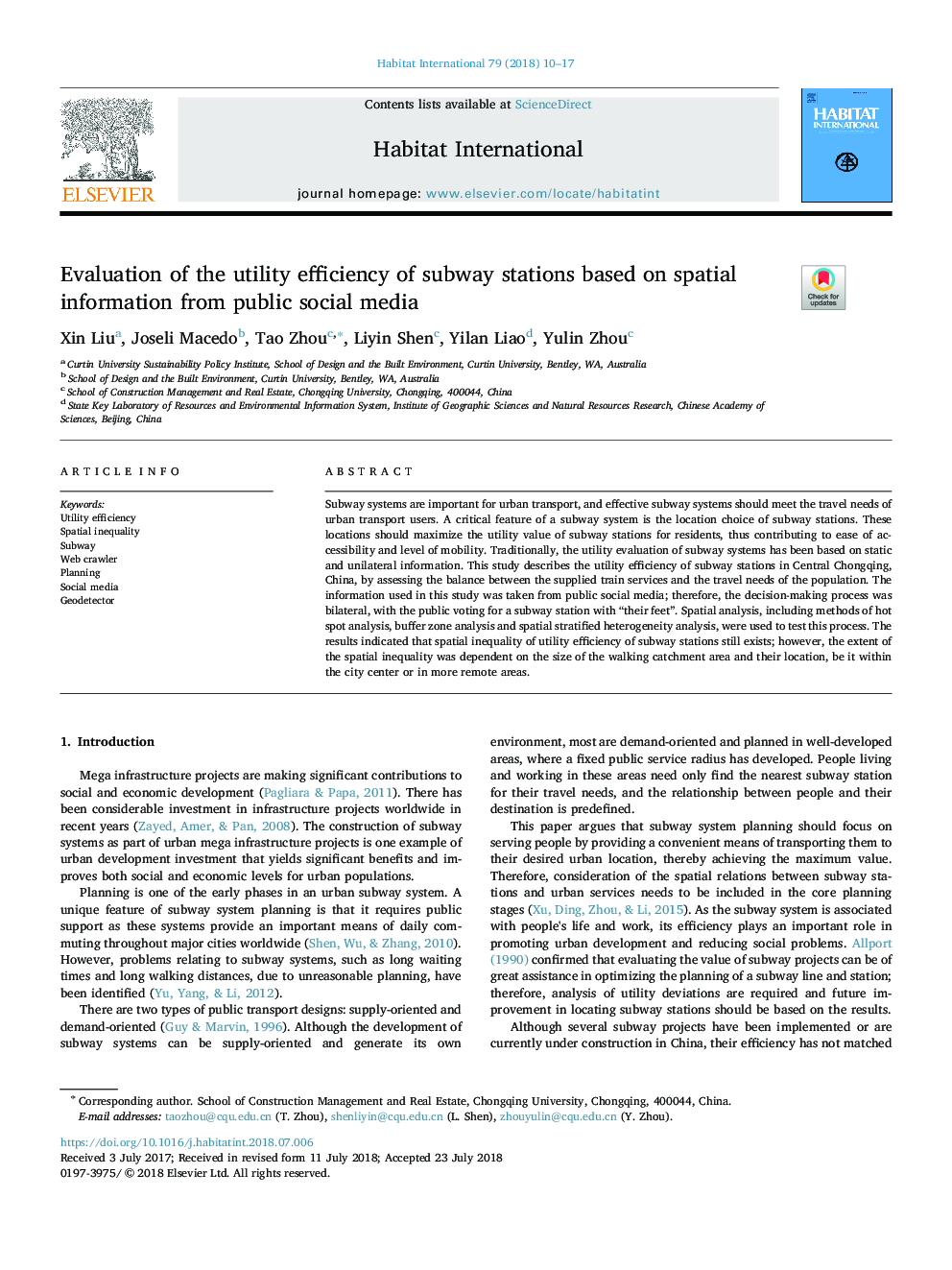| کد مقاله | کد نشریه | سال انتشار | مقاله انگلیسی | نسخه تمام متن |
|---|---|---|---|---|
| 7454877 | 1484465 | 2018 | 8 صفحه PDF | دانلود رایگان |
عنوان انگلیسی مقاله ISI
Evaluation of the utility efficiency of subway stations based on spatial information from public social media
ترجمه فارسی عنوان
ارزیابی بهره وری ابزارهای ایستگاه های مترو براساس اطلاعات فضایی از رسانه های اجتماعی عمومی
دانلود مقاله + سفارش ترجمه
دانلود مقاله ISI انگلیسی
رایگان برای ایرانیان
کلمات کلیدی
بهره وری سودمند، نابرابری فضایی، مترو، خزنده وب، برنامه ریزی، رسانه های اجتماعی، زمین شناس
ترجمه چکیده
سیستم های مترو برای حمل و نقل شهری اهمیت دارند و سیستم های متروی موثر باید نیازهای مسافرتی شهروندان حمل و نقل را برآورده سازند. یکی از ویژگی های مهم سیستم مترو، انتخاب محل ایستگاه های مترو است. این مکان ها باید ارزش افزوده ایستگاه های مترو را برای ساکنین به حداکثر برسانند، در نتیجه به سهولت دسترسی و سطح تحرک کمک می کند. به طور سنتی، ارزیابی ابزار سیستم های مترو بر اساس اطلاعات استاتیک و یک جانبه استوار است. این مطالعه با بررسی تعادل بین خدمات قطار ارائه شده و نیازهای سفر جمعیت، کارایی وسایل ایستگاه مترو در مرکزی چونگ کینگ، چین را ارزیابی می کند. اطلاعات مورد استفاده در این مطالعه از رسانه های اجتماعی عمومی گرفته شده است. بنابراین، روند تصمیم گیری دو جانبه بود، با رای عمومی برای یک ایستگاه مترو با ارتش خود. تجزیه و تحلیل فضایی، از جمله روش های تجزیه و تحلیل نقطه داغ، تجزیه و تحلیل منطقه بافر و تجزیه و تحلیل ناهمگن طبقه بندی فضایی، برای آزمایش این فرآیند استفاده شد. نتایج نشان داد که نابرابری فضایی بهره وری ابزارهای ایستگاه های مترو هنوز وجود دارد. با این حال، میزان نابرابری فضایی به اندازه حوضه حوضه راه رفتن و محل سکونت آنها بستگی دارد، چه در مرکز شهر و چه در مناطق دورتر.
موضوعات مرتبط
علوم انسانی و اجتماعی
علوم اجتماعی
توسعه
چکیده انگلیسی
Subway systems are important for urban transport, and effective subway systems should meet the travel needs of urban transport users. A critical feature of a subway system is the location choice of subway stations. These locations should maximize the utility value of subway stations for residents, thus contributing to ease of accessibility and level of mobility. Traditionally, the utility evaluation of subway systems has been based on static and unilateral information. This study describes the utility efficiency of subway stations in Central Chongqing, China, by assessing the balance between the supplied train services and the travel needs of the population. The information used in this study was taken from public social media; therefore, the decision-making process was bilateral, with the public voting for a subway station with “their feet”. Spatial analysis, including methods of hot spot analysis, buffer zone analysis and spatial stratified heterogeneity analysis, were used to test this process. The results indicated that spatial inequality of utility efficiency of subway stations still exists; however, the extent of the spatial inequality was dependent on the size of the walking catchment area and their location, be it within the city center or in more remote areas.
ناشر
Database: Elsevier - ScienceDirect (ساینس دایرکت)
Journal: Habitat International - Volume 79, September 2018, Pages 10-17
Journal: Habitat International - Volume 79, September 2018, Pages 10-17
نویسندگان
Xin Liu, Joseli Macedo, Tao Zhou, Liyin Shen, Yilan Liao, Yulin Zhou,
